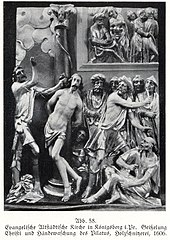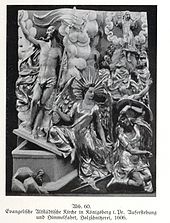High altar of the old town church (Königsberg)

The high altar of the old town church of St. Nikolaus in Königsberg is a mannerist carved altar made in 1606 . When the Old Town Church was demolished in 1826/1828, the altar was moved to the New Town Church in 1838. During the Second World War , the plant was dismantled in 1943 and relocated to Arnau . Since then, the high altar has been considered lost.
description
The predella showed two groups of sculptures. A three-dimensional group of figures represented the Feast of Passover ( Seder evening ) and the other group of figures represented the Last Supper . In the niches of the pedestal there were two figures, presumably representing apostles.
The main floor was designed in the style of Gothic shrine altars. The main floor consists of five relief panels, consisting of a fixed middle section and two movable side wings on each side. The solid middle part showed the crucifixion group , consisting of the crucified Jesus and the two crucified thieves . In addition, the two Marien with Johannes as well as the war people and the soldiers throwing the dice. On the left upper open side wing Jesus on the Mount of Olives and the kiss of Judas were depicted, while on the left lower side wing the flagellation of Christ and the washing of the hands of Pilate were shown. On the right upper side wing Jesus was shown before Caiaphas and the carrying of the cross , while on the right lower side wing the resurrection and ascension of Jesus were shown.
The first floor showed a narrow middle section, flanked by two oval medallions . In the middle part the birth of Jesus with Mary and Joseph was depicted, as well as two standing and two kneeling shepherds. Numerous putti surrounded the scene. In the oval medallion on the left side wing, the Transfiguration on Mount Tabor with the Savior as well as Moses and Elias are depicted as half-figures in the clouds with Peter, John and James. Two apostles stand above it. The Annunciation to Mary is depicted in the oval medallion on the right side wing. Above it were allegories of two virtues, including one on faith.
The second floor was adorned with the Passover lamb in the middle and with allegories of faith, hope, love and justice. At the very top was the figure of the Evangelist Matthew .
Art historical significance
According to Dehio, the work was an "achievement of northeast German mannerism" and its artistic significance corresponded to the Überlinger Altar by Jörg Zürn (1616) and the Altar in Varel by Ludwig Münstermann (1614) or the Erfurt Altar by Hans and Paul Friedemann (1625) . According to Georg Dehio and Ernst Gall , the altar combines elements of the Italian Renaissance (“flatness of the whole”) with those of the Nordic Renaissance (“the elements of the decoration spinning over all structures”). You suspect a Königsberg sculptor's workshop, because of its effect on sculptors who were active at the same time, and a number of school works.
According to Herbert Meinhard Mühlpfordt , the altar was an “excellent Koenigsberg work, especially the two thieves; about equal in value to Jörg Zürn ”. Anton Ulbrich thinks of Dutch influence. Martin Konrad assigns the work to Johannes van Mildert (1588–1638).
According to Georg Dehio and Ernst Gall, the work is based on the composition of the grave monument for Duke Albrecht .
literature
- Georg Dehio, Ernst Gall; Bernhard Schmid: Handbook of German art monuments. [7], Teutonic Order Prussia . Deutscher Kunstverlag, Munich, Berlin 1952.
- Herbert Meinhard Mühlpfordt: Königsberg sculptures and their masters 1255-1945 . Holzner, Würzburg 1970.
- Martin Konrad: Hans von Mildert, called the German. A Königsberg sculptor in the circle of Rubens and his early days in East Prussia . In: Messages from the authors for the history of East and West Prussia , Volume VI. Pp. 53-56. Koenigsberg 1932.
- Adolf Boetticher (Ed.): The architectural and art monuments of the province of East Prussia. On behalf of the East Prussian Provincial Parliament . Booklet VII. The architectural and art monuments in Königsberg. Bernhardt Teichert, Königsberg 1897, p. 183 .
- Anton Ulbrich: The altarpiece in the Protestant old town church in Königsberg . In: Anton Ulbrich: History of sculpture in East Prussia from the end of the 16th century to around 1870 , 2 volumes, Königsberg 1926–1929, pp. 77–81.
Web links
Individual evidence
- ↑ The structure and content follows Anton Ulbrich: The altarpiece in the Protestant old town church in Königsberg . In: Anton Ulbrich: History of sculpture in East Prussia from the end of the 16th century to around 1870 , 2 volumes, Königsberg 1926–1929, pp. 77–80.
- ↑ a b cf. Herbert Meinhard Mühlpfordt: Königsberg sculptures and their masters 1255–1945 , Holzner, Würzburg 1970, p. 218.
- ↑ cf. Ulbrich, p. 78.
- ↑ cf. Ulbrich, p. 78f.
- ↑ a b c Georg Dehio; Ernst Gall; Bernhard Schmid: Handbook of German art monuments. [7], Teutonic Order Prussia . Deutscher Kunstverlag, Munich; Berlin 1952, OCLC 878777190 . , P. 381.
- ↑ cf. Ulbrich, p. 81.
- ^ Martin Konrad: Hans von Mildert, called the German. A Königsberg sculptor in the circle of Rubens and his early days in East Prussia. In: Messages from the authors for the history of East and West Prussia Volume VI. Pp. 53-56. Koenigsberg 1932.


